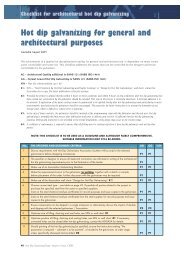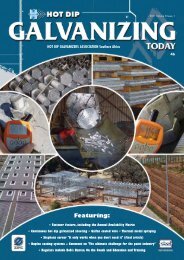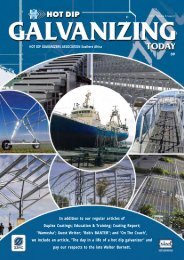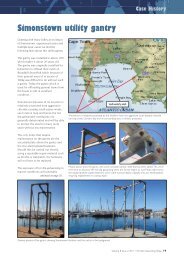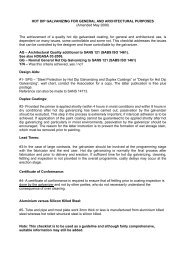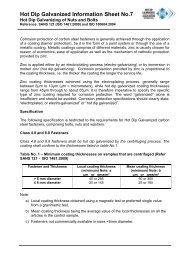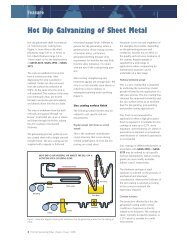Featuring: - hdgasa
Featuring: - hdgasa
Featuring: - hdgasa
You also want an ePaper? Increase the reach of your titles
YUMPU automatically turns print PDFs into web optimized ePapers that Google loves.
Masts, poles and sign gantries<br />
Sign gantry coatings – but what about<br />
the maintenance!<br />
Sign gantries are erected on our<br />
highways throughout the country. For<br />
whatsoever reasons, paint has always<br />
been preferred for corrosion protection.<br />
The painted gantries are usually<br />
painted grey in colour.<br />
Painted structures generally offer a<br />
shorter service life (about 8 to 12 years<br />
dependent on material choice,<br />
preparation of the substrate and<br />
application of the paint coating),<br />
compared to a hot dip galvanized<br />
coatings, particularly in rural<br />
environments (30 to 50 years<br />
dependent on coating thickness which<br />
is determined mainly by the chemical<br />
composition, material thickness and<br />
surface roughness.) Maintenance of a<br />
painted gantry can sometimes be<br />
accommodated when general<br />
maintenance is required on the<br />
highway and occupation is necessary.<br />
However, the two aspects of<br />
maintenance cannot always be coordinated.<br />
Also maintenance painting<br />
will seldom resemble the quality of the<br />
original coating, further reducing the<br />
future service free life, resulting in a<br />
shorter maintenance cycle.<br />
There are, however, some exceptions<br />
to the rule and these are:<br />
The first sign gantry to be hot dip<br />
galvanized was erected on the<br />
Heidelberg Road, just before it joins<br />
the M2 east and west. This gantry was<br />
mainly constructed as a buffer for<br />
trucks packed illegally higher than the<br />
road restrictions of 5.1m. Trucks packed<br />
too high are caught by this gantry<br />
which has been designed to take a 25<br />
ton horizontal load. Once the truck hits<br />
the gantry, the driver is alerted and<br />
then with his damaged truck, can find<br />
an alternative route. The gantry also<br />
fulfils an informative function.<br />
This gantry was hot dip galvanized in<br />
excess of about 20 years ago and has<br />
had very little coating loss. See photos<br />
This buffer sign gantry was constructed some 20 years ago and the hot dip galvanized coating is<br />
very much intact. Coating thickness readings (see table below) prove that the coating is likely to<br />
provide a further 20 to 30 years of maintenance free coating life.<br />
Coating thickness readings (μm) – Taken at ground level<br />
Mean Max Min No. of readings<br />
347 428 274 35<br />
and coating thickness readings in the<br />
table below. With the current corrosion<br />
rate of about 1 to 2µm per year, the<br />
remaining coating is likely to outlast<br />
the design life of the highway.<br />
When considering the initial choice of<br />
coating, besides understanding the<br />
environment in which the product or<br />
project is likely to be exposed to, (ISO<br />
9223 Corrosion of Metals and Alloys –<br />
Corrosivity of atmospheres –<br />
Classification and the Association’s<br />
Information Sheet No. 8 – Corrosion of<br />
Zinc – Corrosivity of Atmospheres). See<br />
our web site. These may be used to<br />
assess the corrosivity of the<br />
environment.<br />
In corrosion categories C1 to C3<br />
(90% of the country), zinc corrodes at<br />
a maximum of 2µm per annum. Even<br />
though most structural steel when<br />
hot dip galvanized will result in a<br />
coating of at least 20 to 50% more<br />
than the minimum required, which is<br />
70µm minimum with a mean of<br />
Painted only sign gantries often require extensive<br />
maintenance within a short period of less than<br />
10 years after installation.When site repainting<br />
does take place in appropriate site conditions<br />
and inadequate substrate preparation due to<br />
difficult application conditions extensively<br />
shorten the required maintenance cycle.<br />
85µm by the specification SANS 121<br />
(ISO 1461).<br />
Future accessibility to all parts of the<br />
component for future maintenance is<br />
also an extremely important<br />
consideration, when specifying.<br />
Holding down bolts and nuts should<br />
also be hot dip galvanized to provide a<br />
28 Hot Dip Galvanizing Today Volume 4 Issue 3 2007



